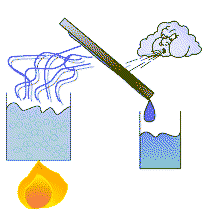Distillation
is defined as:

a
process in which a liquid or vapour mixture of two or more substances
is separated into its component fractions of desired purity, by
the application and removal of heat.
Distillation is based on the fact
that the vapour of a boiling mixture will be richer in the components
that have lower boiling points.
Therefore,
when this vapour is cooled and condensed, the condensate will contain
more volatile components. At the same time, the original mixture will
contain more of the less volatile material.
Distillation
columns are designed to achieve this separation efficiently.
Although
many people have a fair idea what “distillation” means,
the important aspects that seem to be missed from the manufacturing
point of view are that:
 |
distillation
is the most common separation technique
|
 |
it
consumes enormous amounts of energy, both in terms of cooling
and heating requirements
|
 |
it
can contribute to more than 50% of plant operating costs
|
|
The
best way to reduce operating costs of existing units, is to improve
their efficiency and operation via process optimisation and control.
To achieve this improvement, a thorough understanding of distillation
principles and how distillation systems are designed is essential.
The
purpose of this set of notes is to expose you to the terminology
used in distillation practice and to give a very basic introduction
to:
|
|


